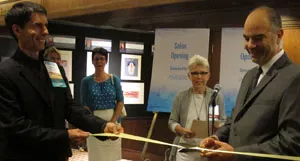
Illuminating Inspiration
In her engaging keynote address, “Perspectives on a Spectacular Profession – Inspiration for our future,” at the 67th Annual Meeting of the Association of Medical Illustrators (AMI), Audra Geras mused about what it takes to be a biomedical illustrator: “We are part scientist, part artist, part interpreter, and part communicator.”
And from July 25 to the 28 the University of Toronto's Mississauga and St. George campuses, along with the Delta Chelsea Hotel in Toronto, served as the converging place for these versatile individuals at AMI’s Annual Meeting; it was only the fourth time in its 67-year history that the event was held in Canada despite the fact that it has a strong Canadian connection.
The U of T Mississauga’s Biomedical Communications (BMC) program is one of just five of its ilk in the world, with an impressive number of alumni making significant contributions to the field. Several BMC faculty members were integral to this year’s meeting, with Professor Marc Dryer serving as the Program Chair, and Professors Linda Wilson-Pauwels, Nick Woolridge, Jodie Jenkinson, David Mazierski and Michael Corrin involved in the conference planning and in sponsorship.
Geras, a U of T graduate with degrees in both biology and art as applied to medicine (now biomedical communications), is a biomedical artist who has been working in the field for the past 20 years. In the keynote address she delivered to the approximately 450 attendees, Geras shared her experiences working in this “continuing education” field and with her boutique studio, Geras Healthcare Productions. She showcased her work, which included limbic system representation, cancerous tumours, and neuron illustrations, along with Geras's fine art, abstract paintings she does as a sideline. Geras spoke of all the qualities that make biomedical illustration so rewarding, but also cautioned the audience about the pitfalls of the industry and provided guidance for heightened business acumen in the field.
The Brödel Memorial Lecture, “Life on Earth – Creating a Digital Biology Textbook,” was delivered by Professor Edward O. Wilson, recognized as one of the foremost biologists in the world, and Professor Gaël McGill from the Harvard Medical School. The duo imparted their experiences in partnering with Apple to create a digital textbook as an iPad download, and how this format will be much more engaging, interactive and dynamic for today's high school students. Forty chapters of the “Life on Earth” textbook will be released over a two-year span.
AMI's four-day meeting, entitled “Illuminate,” had three separate themes for this year’s events: Medical & Scientific Education; Scientific Visualization; and Medical Gaming & Simulation. Attendees had access to a range of workshops, which included anatomical illustration, biovisualization and working with molecular graphics using specific software programs. There were also presentations such as “An Artist’s Role in Scientific Investigation and Communication” and “The Life Cycle of Medical Art (and What will Happen to Yours?).”
A stunning display of biomedical illustrations mounted throughout the event space also provided participants the opportunity to show off their artistry and explore the diverse range of work being created by their colleagues. “One of the goals of our conference is to bring our colleagues and clients closer so that we can share our knowledge and together take advantage of emerging opportunities,” says Linda Wilson-Pauwels, a U of T Mississauga BMC faculty member and past AMI president.
The AMI representatives were thrilled with the turnout, which was the most highly attended meeting in the Association’s history. The next Annual AMI Meeting will take place in Salt Lake City, Utah, July 17-20, 2013.
